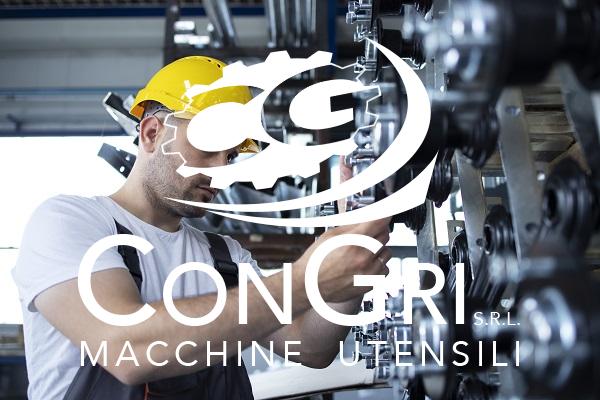Why machine alignment during installation matters for efficiency and precision
When installing a machine tool, the quality of future machining operations largely depends on the precision with which the initial setup parameters are defined. Machine alignment during installation is not just a technical step—it is a strategic activity that affects productivity, component lifespan, and overall operational efficiency. Even small errors in leveling, axis squareness, or the flatness of support surfaces can escalate over time, leading to premature wear, dimensional defects, and unplanned downtime.
ConGri S.r.l., specialized in the sale of new and reconditioned machine tools, supports companies even in the most delicate phases, such as installation and alignment. Thanks to extensive field experience and a deep understanding of machine geometries, ConGri’s technical team ensures an accurate commissioning process, focused on long-term reliability. A proper initial alignment is the first step toward achieving stable, repeatable operations that meet modern industrial requirements.
Machine alignment during installation: leveling as the foundation for precision
Leveling is the starting point of any proper installation procedure. Accurate leveling ensures the machine tool operates under stable conditions and that the forces generated during machining are evenly distributed across the structure. Even a slight tilt can distort the geometry of the workpiece, compromise axis accuracy, and cause unwanted vibrations that reduce surface finish quality.
During machine alignment, leveling is verified using high-precision tools such as electronic levels or digital indicators. It is essential that the machine is placed on a rigid, dry base free of structural imperfections to avoid future sagging. Ambient temperature and humidity are also factors that influence measurement accuracy and must be monitored closely.
To achieve optimal leveling, it is important to check:
- the full contact between the machine base and the floor or foundation;
- the correct adjustment of support feet;
- the machine’s stability after the first hours of operation, as components may settle.
When performed methodically, proper leveling provides the geometric foundation for the next alignment steps, allowing the machine to maintain operational precision over time and ensuring reliable, repeatable production cycles.
Machine alignment during installation: axis squareness guiding quality
Checking the squareness between axes is one of the most critical and delicate stages of machine alignment during installation. If the X, Y, and Z axes are not perfectly perpendicular to one another, every interpolated movement can introduce systematic machining errors, causing deviations in tolerances and finishes that lead to rework or scrap.
Ensuring squareness means verifying that the machine’s movements follow geometrically correct paths without inclinations or misalignments that could compromise complex 3D machining. This step is performed with instruments such as precision squares, laser interferometers, or optical self-leveling systems capable of detecting deviations down to a few microns. Corrections are made by adjusting structural elements or applying software compensations in CNC, when allowed by the machine structure and residual tolerances.
Proper squareness translates into flat parallel surfaces, perpendicular holes, and sharp edges that match the design intent. Especially in sectors where repeatability and machining quality are critical, this geometric control becomes a long-term investment. This is where the experience of machine tool suppliers like ConGri S.r.l. makes a real difference in ensuring the machine is correctly aligned from day one.
Machine alignment during installation: flatness of support surfaces for long-term stability
In the process of machine alignment during installation, the flatness of support surfaces plays a key role in ensuring long-term stability, the absence of torsion, and consistent precision. Even with perfect initial leveling and axis squareness, a non-flat base can introduce internal stresses within the machine structure, undermining machining efficiency and system durability.
That’s why it is essential to verify that the surfaces supporting the machine tool meet optimal flatness criteria, using precision metrology instruments. Any imperfection may lead to progressive misalignment, exacerbated over time by vibrations, dynamic loads, and thermal expansion.
Verifying and ensuring flatness provides several operational advantages:
- maintains geometric integrity during long production runs;
- reduces uneven wear on linear guides, carriages, and ball screws;
- prevents structural micro-shifts that cause dimensional errors;
- distributes loads evenly across the base;
- improves the machine’s dynamic response during acceleration.
Flatness is thus a fundamental element in building a reliable and stable base for precise, repeatable production. A thorough initial check, supported by professional installation services like those offered by ConGri S.r.l., helps prevent operational issues that are hard to detect later.
Relying on an expert for machine alignment during installation: ConGri S.r.l.’s support
Handling machine alignment during installation correctly means laying the groundwork for efficient, stable, and long-lasting operations. Each step—from initial leveling to axis squareness checks and flatness verification—requires specific technical expertise, the right instrumentation, and practical field experience.
Relying on a skilled professional is not just a technical choice but a strategic one. A mistake made during installation can have long-term consequences, including lower productivity, higher maintenance costs, and reduced finished product quality. In this context, support from an expert partner becomes crucial to ensure high and consistent performance.
ConGri S.r.l., a company specialized in selling both new and reconditioned machine tools, also assists clients during the critical installation phase, offering qualified technicians who can perform precise inspections and tailored interventions. ConGri’s approach is based on deep knowledge of machine geometries and the demands of modern production systems, blending hands-on expertise with a vision focused on process optimization.
Choosing professional support means reducing error margins and increasing machine reliability from the very first production cycle—with real benefits for your entire operation.
Click here to get in touch with our team and learn more about our services!
FAQ: machine alignment during installation
Why is machine alignment during installation so important?
Because it ensures machining precision from the very first cycle. Proper alignment reduces vibrations, tool wear, and production rejects, improving both quality and overall system efficiency.
What types of issues can be avoided through proper machine alignment during installation?
It can prevent problems like abnormal tool wear, incorrect part geometry, progressive loss of precision, and unplanned machine downtime due to maintenance.
Who should perform machine alignment during installation?
The alignment should be entrusted to experienced technicians equipped with the right metrology tools and expertise. Support from a partner like ConGri S.r.l. ensures a safe, methodical process at every step.
How often should a machine’s alignment be checked?
Beyond the initial setup, periodic checks are recommended—especially after relocation, impact, unusual vibrations, or major maintenance interventions.
Does machine alignment during installation affect automation systems?
Yes. A correctly aligned machine ensures smooth integration with automation and robotics, avoiding malfunctions caused by mechanical misalignment or positioning errors.

